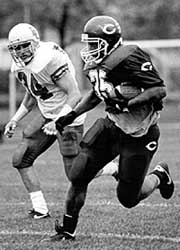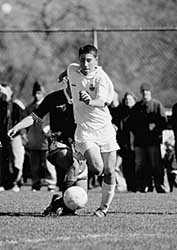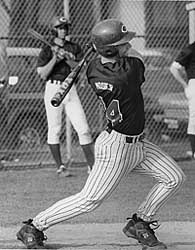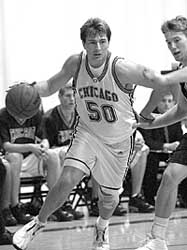- Three Chicago student-athletes have been named Rhodes scholars during the past eight years: Ben Sharp (wrestling, 1996), Erin Bohula (softball, 1999) and Brad Henderson (men’s basketball, 2001).
- Fullback Frank Baker, a two-time Academic All-American, was selected as the NCAA Division III Scholar Athlete of the Year in 1993.
- Men’s soccer player Pat Barry was named an All-American and an Academic All-American in 2001.
- Second baseman Mark Mosier, who led the NCAA Division III in four statistical categories in 1997, was named an Academic All-American. After two years of playing in the San Francisco Giants organization, he enrolled at the University’s Law School.
- Forward Derek Reich was awarded the 2003 Jostens Trophy, which is awarded annually to the NCAA Division III basketball player who best exemplifies success in athletics, academics and community service.
- 127 Chicago student-athletes received University Athletic Association All-Academic Recognition Awards during the 2002-2003 season. The award is presented to athletes in their sophomore year or beyond who have a cumulative GPA of at least 3.20.
No ordinary athletes here: Chicago created the scholar-athlete
By Josh SchonwaldNews Office
 Erin Bohula, a 1999 Rhodes scholar, played softball for the Maroons.  Brad Henderson, a 2001 Rhodes Scholar, played men's basketball for the Maroons.  Frank Baker  Pat Barry  Mark Mosier  Derek Reich |
Varsity athletics at Chicago sometimes seem to be divided into two wildly different eras. There is the pre-1939 era––that of Amos Alonzo Stagg, the Monsters of the Midway and Jay Berwanger, when the Maroons played in the Big 10 Conference and played home football games at a Stagg Field that could hold large crowds. And then there is the era of Division III athletics, when, beginning in 1969, the Maroons––playing in a new, cozier Stagg Field stadium that could seat only 1,650 people––led the way in emphasizing the scholar-athlete ideal.
This modern era of Chicago athletics was recently spotlighted in Reclaiming the Game: College Sports and Educational Values, a new book by William Bowen, president of the Andrew W. Mellon Foundation and former Princeton University president. The book, which overwhelmingly criticizes elite colleges and universities for a “significant, widening divide between the academic and athletic sides of campus life,” singled out Chicago-and its conference, the University Athletic Association-as a model for achieving the right balance between academics and athletics.
But the reality is that the commitment to the scholar-athlete is not at all new at Chicago. Both the Big 10 and Division III eras share a firm commitment to the same ideal: student athletes are students first and foremost.
Gerald Ratner, the namesake of the University’s new athletics center, and a former varsity baseball player at Chicago, recalls that during the early 1930s, “academics were always first at Chicago. There was never any doubt in my mind,” said Ratner, who was a contemporary of Heisman Trophy winner Jay Berwanger. “We were students first, athletes second. Sports were only a supplement to our education.”
Ratner, who graduated Phi Beta Kappa (Ph.B.,’35), attended the College with such distinguished student-athletes as basketball captain and fellow Phi Beta Kappa member Keith Parsons.
The reason, in fact, why Chicago’s sports teams went on a precipitous decline in the 1930s and 1940s was, in large part, because of the school’s refusal to professionalize its athletics programs, according to Robin Lester’s Stagg’s University, which chronicles the rise and fall of big-time football at Chicago.
“Unlike many of its competitors, particularly in football, Chicago insisted on maintaining a true amateurism in sport,” added John Boyer, Dean of the College, “and as a result, its program was at a competitive disadvantage.” In 1939, Look Magazine, not entirely tongue-in-cheek, named Chicago’s last, losing Big Ten team as its All-America team. “The honor,” said Boyer, “was granted precisely because our team was composed of students, and not, as the magazine put it, ‘hired hands.’ ”
When University President Robert Maynard Hutchins pulled Chicago out of the Big 10 Conference in December 1939, Chicago became the nation’s first university to end a major athletics program. But the supremely controversial Hutchins move was in many respects inevitable. “It was becoming more and more difficult for Chicago to compete,” said Ratner. “And it was clear that big-time college sports had no place in the College.” So ultimately, Chicago did not change its standards for student athletes, Ratner said, “the world around it changed.”
During the early part of Amos Alonzo Stagg’s tenure, when Chicago had tremendous success, the athletics program counted numerous distinguished scholar-athletes among its ranks, including two Rhodes scholars-Robert Merrill, a fencing letterman who earned a Rhodes in 1913, and Edwin Hubble, a basketball player on the 1909 team who earned his Rhodes scholarship in 1910, and later became a distinguished scientist for whom the Hubble Space telescope is named.
During recent years, as Bowen wrote in his book, Chicago athletes have considerably furthered this tradition; its varsity athletes have performed at or above the standard set by the student body as a whole and have compiled an extraordinary record of academic accomplishment. Some of the highlights include:
![[Chronicle]](/images/sidebar_header_oct06.gif)